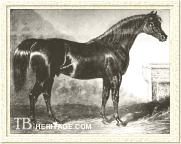 |
| Walton
|
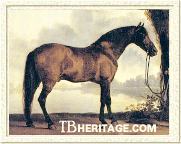 |
| Warde's Arabian
|
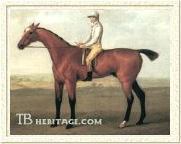 |
| Warter
|
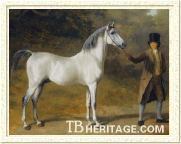 |
| Wellesley Arabian
|
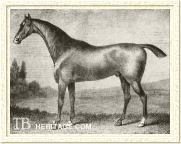 |
| Whisky
|
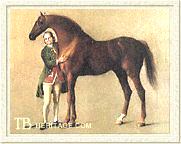 |
| Whistlejacket
|
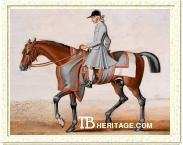 |
| (Godolphin's) Whitefoot
|
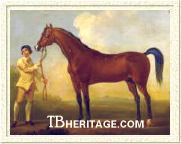 |
| Whitenose
|
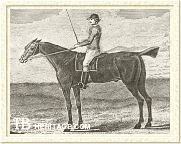 |
| Onslow's Why Not
|
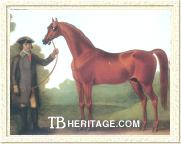 |
| Wilson's Chestnut Arabian
|
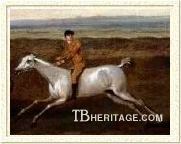 |
| Somerset's Wyndham
|
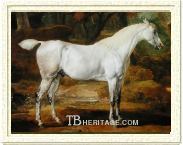 |
| Wynn Arabian
|
|
|
Walnut
SIRE: Highflyer - Herod - Tartar - (Old) Partner - Jigg - BYERLEY TURK. Byerley Turk Sire Line
DAM: Maiden by Matchem - Pratt's Old Mare by Squirt - mare by Mogul - Camilla by Bay Bolton - mare by son of Brownlow Turk - Old Lady by Pulleine's Chestnut Arabian - mare by Rockwood - mare by Helmsley Turk (Family 24).
Bay 1786. Owned and raced by the eighth Duke of Hamilton. Won the Great Subscription Purse at York in 1791. Sired Marybella (1805); siblings Gamenut (1795) and Constantia (1796, taproot of Family 19-b, dam of St. Leger winner Ebor); Sowerby (1797); the race fillies Vanguard (1797) and Sapling (1797). His best youngsters were the racehorses Merry Andrew (1797) and Lignum Vitae (1797); also got Ashton (1806, winner of the 1809 St. Leger).
|
Walpole Barb
See
Orford Turk.
|
Walton
SIRE: Sir Peter Teazle - Highflyer - Herod - Tartar - (Old) Partner - Jigg - BYERLEY TURK. Byerley Turk Sire Line
DAM: Arethusa by Dungannon - mare by Prophet - Virago by (Old) Snap - mare by Regulus - sister to Othello by (Old) Crab - Miss Slamerkin by Young True Blue - mare by Oxford Dun Arabian - D'Arcy Blacklegs mare (Family 7).
Bay 1799. Bred by Sir Hedworth Williamson. Ran between 1802 and 1807, a good winner of such races as the Oatlands handicap and many king's plates at Newmarket and elsewhere over three and four miles. His frequent jockey, Frank Buckle, said he was "always on his head for the first mile" in his races. A popular sire, top of the leading sires list twice, his best son was Partisan (1811, sire of Mameluke and Patron), but he got a number of other good winners, including Phantom (1808, Derby stakes winner); Nectar (1813, winner of the Riddlesworth, the 2,000 Guineas and the 700 Guineas at Newmarket); Leopoldine (1814, winner of the 1,000 guineas at Ascot); Harmodius (Gascoigne Stakes winner); Wrangler (winner of 1,000 guineas at York, 500 guineas at Doncaster, Great Subscription Purse at York); St. Patrick (1817, Doncaster St. Leger winner); Elizabeth (multiple stakes winner); Privateer (winner of the Port Stakes and other top races). |
Warde's Arabian
Apparently imported from Alexandretta in Turkey in 1762, more likely with barb, rather than arabian antecedents. Owned by John Warde of Squerryes Court, Kent, he was covering horses, according to the GSB, beginning in 1763, when he got Arabella from a Young Cade Mare. The only horses listed in the GSB by this horse are Arabella and several unnamed youngsters, all bred by Warde, who was a Jockey Club member. The Warde Arabian also sired horses by the names of Habit, Fairplay and Cleaver, none of whom are in the GSB. The image of the horse on this page is dated 1777, so it seems probable he continued as a stallion for Warde through the 1770s. Warde's son, "Glorious John," was an ardent huntsman, Master of the Pytchley Hunt, 1797-1808, and later Master of the Craven Hunt, 1814-1825; it is possible the Arabian was used to breed hunters. |
Warter
SIRE: King Fergus - Eclipse - Marske - Squirt - Bartlett's Childers - DARLEY ARABIAN. Darley Arabian Sire Line: King Fergus Branch
DAM: Mare by Highflyer - Plotina by (Old) Snap - Miss Cranbourne by Godolphin Arabian - Miss Western by Sedbury - Mother Western by Smith's son of Snake - Old Montagu Mare (Family 12).
Bay 1794. Bred by Gilbert Crompton. Ran for six years, between 1797 and 1802, usually in the top three and against good company. His wins included a 110 guineas purse at York and a £100 purse at Doncaster, beating Pepperpot in six heats over 2 miles in 1797. In 1798, won at Preston and Newmarket, then was sold to John Heathcote. In 1799 he won the Main of the Oatlands 100 guineas, beating Oscar and Diamond, the Stamford Cup, the King's Plate at Lichfield and several other races. In 1801 he won a three mile match for 200 guineas against Jack Andrews, then lost a match to Champion by Pot-8-Os, after which he was sold to Lord Sackville. He won several additional races that year, and in 1802 won a handicap sweep at Newmarket Craven, beating Cockfighter and a four mile 175 guineas purse at Bibury, beating Tag. |
Wastell's Turk
Owned by John Wastell of Yorkshire, his history prior to this is unknown at present; he probably dates to the 1690s. He sired The Pet Mare owned by John Croft (from an (Old) Hautboy mare), who produced a number of foals for Croft, including Grey Woodcock (1720), Rake (1715), Young Greyhound (1718, sire), and an undated filly by Commoner who also produced a number of unnamed foals for Croft. He also sired a mare in the female line of the racehorse called (Curwen/Grisewood) Diamond (1726). The Northallerton Wastell family is probably the same one that produced John Wastell (born in Yorkshire, 1736) a member of the Jockey Club who managed the (3rd) Duke of Grafton's horses, and who also bred and raced his own horses, including the 1802 Oaks winner Scotia. There is a second, later, Wastell Turk in the GSB, who bred a 1771 colt from a Changeling mare for the Duke of Bolton, and probably belonged to the latter John Wastell.
|
Waxy
SIRE: Pot-8-Os - Eclipse - Marske - Squirt - Bartlett's Childers - DARLEY ARABIAN. Darley Arabian Sire Line: Pot-8-Os Branch
DAM: Maria by Herod - Lisette by Snap - Miss Windsor by Godolphin Arabian - mare by Young Belgrade - mare by Bartlett's Childers - mare by Devonshire Turk - mare by Curwen Bay Barb - mare by (Old) Spot - mare by (Old) Woodcock (Family 18).
Bay 1790. Bred and raced by Sir Ferdinand Poole, trained by the innovative and successful Robert Robson. Won, among other races, the Epsom Derby, a £50 plate over 4 miles at Newmarket and the Jockey Club Plate at Newmarket Second Spring in 1794, and the King's Plate at Salisbury in 1796, beating his generational rival, Gohanna, in each of these, losing to him only once in a 100 guineas match where he conceded 3 pounds. He was called "...one of the finest formed horses, perfect in symmetry, beautiful in color, admirable in all his paces, and of the finest temper, when in work." Purchased by Richard, Earl of Grosvenor, to stand at stud; sold in 1808 to Augustus Fitzroy, (3rd) Duke of Grafton where he became a principal progenitor of the Darley Arabian sire line. Highly significant sire, he established several long-lasting branches of the Eclipse line -- via the fortuitous cross with the great mares Penelope (by Trumpator) and Prunella (by Highflyer) -- through sons Whisker (1812, Derby winner), Whalebone (1807, Derby winner), Waxy Pope (1806, Derby winner), Woful (1806), and Blucher (1811, Derby winner, from Pauline). He also got three Oaks winning daughters: Music (1810), Minuet (1812), and Corinne (1815), and a number of other winners and important broodmares, including Pledge (dam of Tiresias), Pope Joan, Web (1808). |
Wellesley Grey Arabian
Grey Imported 1803. Brought to England from India by Henry Wellesley, the youngest brother of the Duke of Wellington, who served in a governmental position in India, where there was considerable traffic in the sale of horses from elsewhere in the Middle East. One judge of horses in 1809 thought the horse was "Persian or Syrian, with a considerable admixture of Arabian blood." The horse was described in the Sporting Magazineof 1810 as one of "great substance and power," who had already gotten winners of short races at Newmarket. Stood at Cheshunt, Hertfordshire. He was among the last, if not the last, imported Arabians to produce good racehorses, albeit in the second generation: he sired Fair Ellen (1806), who produced Lilias, winner of the Oaks in 1826, two daughters who placed second in the Oaks, and a colt, The Exquisite, who ran second in the Derby but was a failure at stud. The Wellesley Chestnut Arabian was purchased and imported by Wellesley at the same time, and also stood at Cheshunt. |
Whalebone
SIRE: Waxy - Pot-8-Os - Eclipse - Marske - Squirt - Bartlett's Childers - DARLEY ARABIAN. Darley Arabian Sire Line: Whalebone Branch
DAM: Penelope by Trumpator - Prunella by Highflyer - Promise by Snap - Julia by Blank - (Old) Partner - Bonny Lass by Bay Bolton - mare by Darley Arabian - mare by Byerley Turk - mare by Taffolet Barb - mare by Place's White Turk - Tregonwell's Natural Barb mare (Family 1).
Brown 1807. |
Whiskey
SIRE: Saltram - Eclipse - Marske - Squirt - Bartlett's Childers - DARLEY ARABIAN. Darley Arabian Sire Line: Eclipse Branch
DAM: Calash by Herod - Teresa by Matchem - Brown Regulus by Regulus - Miss Starling Jr. by Bolton Starling - Ringbone by (Croft's) Partner - Chestnut Thornton by Makeless - Old Thornton by Brimmer - mare by Dicky Pierson - Burton Barb mare (Family 2).
Bay 1789. Bred by the Prince of Wales, who also owned his good sire, Saltram. Good racehorse and sire who established his own branch of of the Eclipse sire line for a few generations, but had a lasting impact on the breed through his daughters. Ran for only 2 years at ages 3 and 4, overshadowed by his generational rivals John Bull and Bustard. At 3 ran sixth in the Derby stakes, later won a 200 guineas 2 mile sweep for 3 year olds at Newmarket, a£50 purse at Bedford, a 1,000 guineas sweep at Newmarket October, the Great Subscription Purse of 1400 guineas at Newmarket Spring meeting, and a match against Sir John in the fall at Newmarket. Sold to J.H. Durand, at 4 he won the Newmarket First Spring Jockey Stakes of 100 guineas, and several smaller races. He was retired at the end of his 4 year old season and sold to Sir Charles Bunbury who sent him to his stud. There he got Bunbury's good racehorses Orlando and Whirligig (1798, also sire), and the racehorses and sires Patriot (1805), Jupiter (1805), Pioneer (1804) and Marmion (1806). His daughters included Eleanor (1798, winner of the Derby and the Oaks, dam of Muley); Pelisse (1801, winner of the Oaks); Julia (dam of Phantom); Cressida (dam of Priam), and a number of other good racing fillies and broodmares. |
Whistlejacket
SIRE: Mogul - GODOLPHIN ARABIAN
DAM: Mare by (Bolton's) Sweepstakes - mare by Hampton Court Chestnut Arabian - sister to Brown Farewell by Makeless - mare by Brimmer - mare by Place's White Turk - mare by Dodsworth - Layton Barb mare (Family 4).
Chestnut 1749. Bred by Sir William Middleton of Northumberland. A good racehorse, he won a famous match for 2,000 guineas over 4 miles at York in 1759, beating Brutus by a length. Sold to the second Marquess of Rockingham and was retired to Rockingham's stud. Sired colts Coriolanus (1762) and Roscius (1767) and a filly Laura (1766), all from Pretty Polly, but did not leave much of a mark on the breed. Made famous by George Stubb's dramatic portrait (the one shown is a less known portrait of the horse, also by Stubbs). |
White-Legged Lowther Barb
Owned by Sir John Lowther, (2nd) Baronet of Lowther, Westmoreland, whose family had been staunch royalists during the Civil War. Lowther was an active supporter in the north for securing the English throne for William (III) and Mary, and was later rewarded by important posts, including positions as privy councillor and lord-lieutenant of Westmoreland, and was elevated to the peerage in 1696, created Baron of Lowther and Viscount Lonsdale. The White-Legged Lowther Barb was described as a "little barb" by Henry Curwen of Cumberland, who bred a filly by him from his Vintner mare (Family 9). This filly, who must have been born around 1685-90, "the White-legged Lowther Barb mare," consequently became the main conduit of descent of horses in Family 9, primarily through her daughter by (Old) Spot, also bred by Curwen, dam the famous Mixbury Galloway and his two sisters (one, the dam of (Old Partner and ancestress of (Old) Crab, Devonshire Blacklegs, Hip, Second, and Snip; the other dam of Sloven), and of Frampton's Whiteneck, a racemare in 1710-11 and ancestress of Pacolet. He was a chestnut, and the White Legged Lowther Barb mare appears to be his only produce listed in the GSB. The Lowther family had been racing horses in the north since at least the time of Charles II, and the Lowther stud continued to produce top racehorses through the mid-nineteenth century.
|
(Godolphin) Whitefoot
SIRE: Bay Bolton - Grey Hautboy - (Old) Hautboy - WHITE D'ARCY TURK
DAM: Mare by Darley Arabian - mare by Byerley Turk - mare by Taffolet Barb - mare by Place's White Turk - Tregonwell's Natural Barb Mare (Family 1).
Bay 1719. Bred by Sir William Ramsden, purchased by Francis, (2nd) Earl of Godolphin. The horse was utilized frequently as a stallion by Edward Coke (first owner of GODOLPHIN ARABIAN) at his stud in Derbyshire in 1732-33, by the 2nd Earl of Godolphin in Cambridgeshire up through 1737, and by Sir John Dutton at his stud in Gloucestershire, also in the 1730s. Stood at the Godolphin stud at Babraham. He was an unbeaten racehorse during the 1720s, running in matches at Newmarket for five years, beating, among others, Bay Wilkinson, True Blue (1725), Panton's Osmyn, and the Duke of Somerset's Cinnamon (1728) for substantial sums that exceeded 1,000 guineas over the course of his career. He got quite a few foals between 1731 and 1737, including the King's Plate winners Molotto (1736) and Tortoise (1737). His main impact on the breed comes from a daughter born in 1731 from a mare by Leedes who was bred by Sir John Dutton. She is seen in tail-female descent in Family 21, a grandaughter of the Moonah Barb mare. This mare produced the racehorse Sherborne (1738, by Hobgoblin), the racehorse and sire Bajazet (1740, by Godolphin Arabian), and four good daughters: The Hobgoblin mare (1736), dam of Fly (1741) and Noble (1744); Brown Betty (1737), dam of Infant (1746, sire), Sophia (1748), Mizra (1749, racehorse and sire); Miss Dutton (174-); Shireborn (1739), dam of Saxham (1744, dam of Alcyhmist, Hogmagog), Chub (1746, racehorse and sire), Emma (1751, dam of Hero), the Godolphin Gelding (1748, racehorse), and the famous Selima (1745, exported to Virginia and unbeaten racehorse there, ancestress of Hanover and Foxhall). He also got the dam of Jenny Dismal, another mare imported to America, where she was a significant Virginian matriarch. Whitefoot also sired a sister to the Whitefoot mare (1733), who produced the racehorse Ajaz (1747) and the gelding Skewball (1741), the latter immortalized in song. He also sired Whitefoot (1734) sent to Ireland; a number of unnamed colts and fillies between 1731-35 from Young Kitty Burdett (1720), who was in Dutton's stud; Tortoise (1737, not the later famous one by Snap) and his sister (1736, dam of the famous Gower Stallion); Slamerkin (1739) from Miss Slamerkin; and a number of unnamed colts and fillies in the 1730s. |
(Routh's) Whitefoot
SIRE: Hip -CURWEN BAY BARB.
DAM: Northern Nanny by Highland Laddie - mare by Byerley Turk.
Chestnut 1731. Bred by Cuthbert Routh, Snape Hall, Yorkshire. Ran between 1735 and 1739 in the north. Routh sold him, at age 9, to a Mr. Cornwall for 50 guineas in 1740. He does not appear in the GSB. |
Whitenose
SIRE: GODOLPHIN ARABIAN. Godolphin Arabian Sire Line
DAM: Mare by Flying Childers (Sister to Blaze) - Confederate Filly by Grey Grantham - mare by Duke of Rutland's Black Barb - Bright's Roan mare (Family 61).
Bay 1742. Bred by Sir William Middleton -- or possibly Thomas Panton -- in 1742, he never raced. He was considered among the top ten of the Godolphin Arabian's sons, having got the good racehorse and sire, (Onslow's) Victorious; Aaron (1747, who ran in the controversial match against Little Driver); Cleopatra (1754); Pegasus (1754), Wasp (1753), Cassandra (1754); Miss Stamford, dam of the good racehorse Defence; the excellent racemare Duchess (Fenwick's), winner of seven King's Plates and later the dam of Le Sang, Chymist, Playfellow and Pyrrha (Family 7); and many other racehorses and broodmares. His daughter Cassandra was sent to Virginia carrying the filly Stella (1764, by Shakespeare) in-utero; Stella was the dam of an early noted American stallion (Harris') Eclipse. Whitenose was owned for a while by Thomas Panton of Newmarket, and then by Charles Spencer, (3rd) Duke of Marlborough, who presented him to his friend, Charles Colyear, the second Earl of Portmore for his stud; At stud at Hampton Court, Surrey until 1753; he died at Doncaster in 1755 "...at the time of his coming into great fame as a stallion." |
(Heneage's) Whitenose
SIRE: HALL'S ARABIAN
DAM: mare by (Old) Jigg - mare by son of the Lister Turk - mare by Brother to Snake (Family 69).
Bay 1722. His principal stake in the stud book is through his famous daughter, Silvertail (1737, from a mare by Rattle), who was the dam of (Warren's) Careless (1751); Sportsman (1753, by Cade); Fearnought (1755, by Regulus), and Whimsey (1747, by Cullen Arabian, dam of Dragon and Maria Careless by Regulus).
|
Whiteshirt
Despite references to him in old pedigrees as "famous old Whiteshirt," there is no mention of him in the GSB other than in the progeny of a mare by Old Montagu (Family 12), where he is critical, since his daughter, the mare by Whiteshirt, is responsible for carrying on a good portion of that female line. However, the Whiteshirt Mare, that heads the Family 12-a branch, and all her progeny, do not have the same tail-female line as the rest of Family 12, being out of a "famous" mare of Lord Montague's, and not out of a mare by Old Montagu, which was born much later. She may be related tail-female to Family 68, or barring that, is another family altogether whose root should be another titled "Lord Montague's Mare." According to Cuthbert Routh's stud book, Whiteshirt was also the sire of Sir Robert Bainton's bay Diamond. Bainton preceded Tregonwell Frampton as Keeper of the King's [Charles II, William III] Running Horses at Newmarket. It is possible Whiteshirt was a stallion, known to historians by another name, at James D'Arcy's Sedbury stud in Yorkshire, which supplied racehorses to King Charles II. |
(Old) Whynot
SIRE: FENWICK BARB.
DAM: A Royal Mare.
Grey c.1678. Bred and owned by Sir John Fenwick (3rd) Baron of Wallington, Northumberland, who owned his sire. As a supporter of James II, Fenwick was implicated in Jacobite plotting and was ultimately executed in 1697. A famous horse named Why Not, owned by Sir Robert Carr, scion of another Catholic Northumberland family, ran at Newmarket between 1681 and 1684, if not later, beating Tregonwell Frampton's horse, Dragon, in matches both in 1682 and 1684. Whynot sired Grey Whynot (Family 15), the dam of the important sire Bald Galloway, the mare Points, and Cupid, also a racehorse and sire, all by the St. Victor Barb. Grey Whynot or a sister to her produced a filly by Bethell's Castaway who has her own branch of Family 15. He probably also got a mare for James D'Arcy, called D'Arcy Whynot Mare (1702), who was in the Duke of Newcastle's stud beginning in 1709 producing foals by the Pagett Arabian, and "ye Old Whynot Mare" in the Duke of Ancaster's stud. In some pedigrees, including the GSB, (Old) Whynot is credited as the sire of the racehorse and sire horse (Old) Snail, and his sister who is seen in Family 43, but this Snail is specifically stated in the GSB to be the Duke of Wharton's, that ran in 1718, and therefore was born no earlier than 1712, leading to the conclusion that the Whynot that got this Snail was a later horse, possibly a son of Old Whynot. In some pedigrees this probable other Whynot is referred to as "Bay Whynot," and as "Wilkinson's Whynot." A Wilkinson's Whynot also got the (Tankerville) Why Not mare (Family 62) supposedly born in 1711-12, who was the dam of Bay Wilkinson (1717). |
(Onslow's) Whynot
(Old) Crab - ALCOCK ARABIAN
DAM: Sister to Slipby by (Old) Fox - Gipsey by Bay Bolton - mare by Duke of Newcastle's Turk - mare by Byerley Turk - mare by Taffolet Barb - Mare by Place's White Turk - Tregonwell Natural Barb mare (Family 1).
Black 1744. Bred by Sir John Philips of Wales. A sturdy, game racehorse who ran in country meets, he started in 1749 at Hounslow, winning £50, beating the mare Fancy (also by Old Crab). In 1750 he won at Epsom, Stamford, Burford and Chesterfield, and then was purchased by George, (1st) Earl of Onslow. Between 1751 and 1753 he ran mostly four mile heats, winning at Guildford, Maidenhead, Leicester, Northampton, and Hounslow, but was beaten by Garland (three times), by Little Driver and by Aaron at ages 8 and 9 when he was past his best. Retired to stud, he failed to breed on. He died at Belsize, near Hampstead, in 1761. |
Wildair
SIRE: Cade - GODOLPHIN ARABIAN. Godolphin Arabian Sire Line
DAM: Mare by Steady - mare by (Old) Partner - mare by Greyhound - Chestnut Layton by Makeless - Bay Layton by (D'Arcy) Counsellor - mare by Brimmer - mare by Place's White Turk - mare by Dodsworth - Layton Violet Barb mare (Family 4).
Bay 1753. This horse was purchased by James DeLancey of New York and imported into the U.S. in 1765, one of a number of mares and stallions of Godolphin Arabian blood he imported, having seen the first generation run while at school at Cambridge. In America Wildair produced a number of winners, such as Angelica, Bashaw, Poppet, (Simm's) Wildair, Sultana and others, his lasting influence there due primarily to the offspring from his cross on the Cub Mare, "grandmother of the American turf." Forseeing the upcoming war with Great Britain, DeLancey auctioned off his stock in the U.S., but Wildair was sold back to England (DeLancey later followed with his family), purchased by Edward Leedes of Yorkshire in 1773. In England Wildair bred a number of horses between 1775 and 1780, primarily from Leedes' mares. There he got the colt May Flower (1776), the racehorse Telemachus (1775), and Tommy (1776), who won the St. Leger in 1779. |
Wilkinson's Bay Arabian
The Wilkinsons of Yorkshire were apparently early breeders of oriental horses. Henry Bennet, Earl of Arlington and Lord Chamberlain for Charles II and father-in-law to Henry Fitz Roy (1st Duke of Grafton), Charles' natural son, gave Mr. Wilkinson a barb mare (Arlington Barb Mare, Family 43), probably just before his death in 1685; Lord Arlington was also a racing enthusiast and horse breeder. The Arlington mare's daughter, by the Wilkinson Bay Arabian, produced the racehorse, (Old) Snail (c.1693, by Whynot) and his sister, who continued Family 43. The Wilkinson Bay Arabian is probably the same horse as the Wilkinson's Barb seen in Family 6 as the sire of The Wilkinson Barb Mare from Bald Peg (almost certainly Young Bald Peg, and not her grandam), who was the dam of the racehorse Lilliput (by the Bald Galloway), a filly by Gray Grantham, who continued this branch of Family 6 to such horses as King Fergus, and a filly by the Bald Galloway. A horse called the Wilkinson Barb is also seen in Family 71, having been bred to a mare by Rider's Cupid, who might be the same horse, as well, although his dates seem to be a bit later. The Wilkinson Bay Arabian may also be the same horse as the Wilkinson Turk seen in Family 62, who was bred to an (Old) Woodcock mare, producing a filly who was the dam of the Why Not mare in 1711-12. |
Williams' Woodstock Arabian
This horse probably was owned by a descendant of Sir John Williams, who received a grant of a number of farms in Berkshire and Oxfordshire from Henry VIII, and was created Lord (Baron) Williams of Thame in 1554 by Henry's daughter Queen Mary. With two consecutive wives he had 25 children; in 1558 he established a free grammar school in the town of Woodstock, Oxfordshire (adjacent to the Duke of Marlborough's Blenheim Palace), extant today and he is buried at nearby Thame Park, Berkshire. The horse is periodically described as Williams of Woodstock Arabian, and is probably associated with this family. He is important in thoroughbred bloodlines for siring the mare Flying Whigg (1715 or 1721, Family 15) for Francis (2nd) Earl of Godolphin from the St. Victor Barb mare, Points, a sister of the Bald Galloway. Flying Whigg produced two important daughters, Amoret (1727, the "Little Hartley Mare," by Bartlett's Childers) and Sachrissa (1729, the "Large Hartley Mare" by Hartley's Blind Horse). Amorett produced Tortoise (1737), Janus (1738), Blank (1740), Old England (Slugg, 1741), and Miss Meredith (1751, seen in Family 15). Sachrissa produced the good sire and racehorse Mogul (1735), racehorse and sire Babraham (1738), and a 1733 filly by Hip seen in Family 15. Williams' Arabian also sired Tregonwell Frampton's racehorse, Pontz. |
Wilson's (Chesnut) Arabian
The horse was brought into England by a Mr. Fitzhugh, after being obtained by George Hay, (7th) Earl of Kinnoul for £200 sterling while ambassador to the court of Constantinople during the reign of George I. He probably originated near Aleppo, since his "true pedigree" was "...attested in presence of many Witnesses before the Solemn Judge of the High Court of Judicature at Alepo." Described as "compact and powerfully made." Sold to Charles Wilson, who stood him at Oran, near Catterick in Yorkshire. He sired the "famous" chestnut mare, Primrose in 1754, who was purchased by the Duke of Northumberland for his stud and then produced Belinda (1766) and the colt Furioso (1767), both by arabians. Also sired a very good racehorse, Narcissus (1756), from a Cade mare, bred by the Duke of Northumberland. The Duke utilized this stallion several times, also breeding the filly Lais (1755); the dam (1760) of Liberty; and the colts Salamander (1755), Beggar (1755), Polydore (1757) and Nimrod (1755, Family 65). For others, the Chestnut Arabian got Miss Teasdale (1755), Negro (1758), Jingle-Jeffrey, and several others. His covering dates range from 1753 through 1757; it is presently unknown if he continued in someone else's stud under a different name after that. |
Wolseley Barb
This horse was covering mares 1755 - 1769, several for Richard, Earl Grosvenor. He may have been imported or owned by one of the Wolseleys, the family seat at Wolseley Hall near Colwich, Staffordshire; one horse, Sloven (1758), by the Wolseley Barb from a Devonshire Blacklegs mare, was bred by Sir William Bagot, whose family seat was also in Staffordshire. Other Wolseley Barb youngsters listed in the GSB include Raphael (1755), Riddle (1762), and several unnamed foals, none of whom appear to have made much of a mark on the breed. |
(D'Arcy's) Woodcock
SIRE: Bustler - HELMSLEY TURK
DAM: Not provided.
Probably bred by James D'Arcy (the younger) at Sedbury, Yorkshire, and probably stood at the D'Arcy stud. The above pedigree is barely plausible for the D'Arcy Woodcock whose foals were born 1717-1723; Bustler appears to have been siring horses in the early 1690s, and another of his sons, the famous Old Merlin (169-), sired Castaway in 1705 (and also sired a Woodcock, see (Merlin) Woodcock below). The history and progeny of the various Woodcocks are muddled; there were some Woodcocks who ran as early as the 1670s. Horses specifically attributed to "D'Arcy Woodcock" in the GSB include: Doll (1721, from the Moonah Barb Mare, Family 21), dam of the good racehorse and sire, Rib (1736, by Crab), and ancestress through a daughter of Skewcap and Comet (both by Cade); Old Montague (c.1720, Family 68 taproot mare), dam of Sedbury; a 1723 filly from a Holderness Turk mare who was the dam of two foals by Hartley's Blind Horse. Horses that almost certainly were by the D'Arcy Woodcock include: Mad Darcy (1719, from Young Violet Layton mare in D'Arcy stud). Horses that were probably sired by the D'Arcy Woodcock, because their breeder, John Croft, of Barforth, Yorkshire, and his father before him, were both closely associated with the D'Arcy family and stud at Sedbury include: Woodcock Thornton (1718, Family 2), dam of Margery (1730) and ancestress of mares in Family 2 and of the grey colts Rib (1751 by Rib) and Careless (1752 by Rib); The Darcy Brown Woodcock (1717, Family 2), ancestress of Lass of the Mill (by Old Traveller), Miss Makeless and others in that line; Grey Woodcock (1720, from Croft's Pet Mare), second dam of Pegasus (1754, by Whitenose); two unnamed colts (1718, 1720) from Bay Farewell (by Makeless); a filly (1720) bred by Croft from a Curwen Bay Barb Mare (sister to Little George, dam of Sophonisba). Also likely offspring of this horse include: Brocklesby (1723, colt, from Brocklesby Betty), bred by (1st) Earl of Godolphin. Another female line, Family 18, Old Woodcock Mare (from whom the important sire Waxy probably descends, and the race horse and sire Essex's Smiling Ball), is also attributed to the D'Arcy Woodcock [J.B. Robertson, "Origin of the Thoroughbred," in Flat Racing (Lonsdale Library, V. 28)], although he places the birthdate of the D'Arcy Woodcock prior to 1690. Also, the Old Woodcock mare at the head of Family 62, by D'Arcy's Woodcock according to the Turf Register, dates to around 1700 at the latest, and was probably by the same Woodcock as the Family 18 Old Woodcock Mare. It is probable this particular Woodcock, whether another owned by D'Arcy, or a different one altogether, is an earlier Woodcock dating prior to the mid-1690s, possibly the Duke of Rutland's D'Arcy Woodcock who ran in the late 1680s, which accords better with the Bustler-Helmsley Turk sire line.
|
(Davill's) Woodcock
Pedigree not stated; GSB states it is not known if this is the same horse as D'Arcy's Woodcock by Bustler. Credited with siring the foundation mare of Family 19, he probably dates to the 1690s or a little earlier and is only seen in the female line extending from the Family 19 mare, which runs: Davill's Old Woodcock - mare by Luggs - mare by Snake, and then branches to various mares who produced horses such as Miss Mayes (1737, Skim's dam). |
(Merlin) Woodcock
SIRE: (Old) Merlin - Bustler - HELMSLEY TURK.
DAM: Sister to Ruffler by son of Brimmer - Dick Burton's mare (Family 31).
Bay. Bred and run by Hugh Bethell of Yorkshire. Brother to Castaway, and a filly by the Darley Arabian, the latter establishing a line leading to such racehorses as Wanton, The Speaker and Chicle (Family 31). The information on this horse is contradictory. In the 1920s C.M. Prior was shown a gold cup by Mr. Bethell, a descendant of the breeder of Woodcock and other early 18th century horses. The cup, presented by Queen Anne, had Woodock's name engraved on it, and the date of 1708, won at a race on Bramham Moor in Yorkshire. Prior then concluded that the Merlin Woodcock would have been born in or around 1703, rather than 1715, as stated in the GSB, which also accords better with the birthdate of his brother, Castaway (1705). However, a detailed account of several races at York, Lincoln and Newmarket in 1721-22 between (Duke of Rutland's) Prosperine and Mr. Frampton's grey gelding and purportedly the Merlin Woodcock is provided in Taunton's Famous Horses (1901), although the name of the owner and breeder of this Woodcock is not indicated, only that he was supported by Yorkshire sportsmen. Cook (History of the English Turf) also describes these races, which turf writers consider of interest due to the rivalry between racing men in the north and south of England, and says it was the Merlin Woodcock, owned by [John] Raikes Fulthorpe (of Yorkshire). Since the races are so well documented, it seems likely the Woodcock who won at Bramham Moor in 1708 was another Woodcock, whether owned by Bethell or someone else. It is unclear if the Merlin Woodcock ever sired any horses in the GSB; if he is indeed the horse that ran in 1721-22, it is unlikely he is the sire of any seen in the various pedigrees in the GSB, since most horses by any Woodcock appear to have been born prior to 1720.
|
Woodpecker
SIRE: Herod - Tartar - (Old) Partner - Jigg - BYERLEY TURK. Byerley Turk Sire Line
DAM: Miss Ramsden by Cade - mare by Lonsdale Bay Arabian - sister to Bonny Lass by Bay Bolton - mare by Darley Arabian - mare by Byerley Turk - mare by Taffolet Barb - mare by Place's White Turk - Tregonwell natural barb mare (Family 1).
Chestnut 1773. Bred and run by Sir Charles Davers of Suffolk. One of Herod's better sons, he was a good racehorse in the late 1770s and early 1780s, his principal achievements were his wins of the Craven Stakes in 1778, 1779 and 1781, beating large fields, and a 1400 guineas handicap sweep in 1780, beating Pot-8-Os, who he beat again in a 140 guineas purse at Newmarket in 1781. Described as a large, coarse horse with wide lop ears, he went to stud at Lord Egremont's Petworth stud. Like Highflyer, he established a Herod sire line branch, producing over 100 winners. His best sons were Buzzard (1787, sire of Castrel, Quiz, Rubens, Selim), Chanticleer (1787, sire of Bob Booty), Dragon (1787); Young Woodpecker. He also got the filly Ephemera (1800, winner of Epsom Oaks), and the good mares Wren (dam of Oaks winner Bellissima) and Woodbine (dam of Oaks winners Music and Minuet); Martha; Colibri (dam of Derby winner Cardinal Beaufort) and her sister Catherine (dam of Golumpus, the sire of Catton), both significant in Family 11; Grey Skim, and Chestnut Skim, all of which produced winners to the cover of Gohanna. He died in 1798. |
(Old) Wyndham
SIRE: (Old) Hautboy - D'ARCY WHITE TURK.
DAM: Mare by Selaby Turk - mare by Bustler - mare byPlace's White Turk- mare by Dodsworth (Family 54).
Grey c.1704. This horse was owned by the sixth Duke of Somerset, when he ran at Newmarket in 1710 in a match against Bay Bolton, which he lost, but he won a 500 guineas match in 1712 and a 300 guineas match in 1713 against Bay Bolton, and a 300 guineas match against Frampton's Dragon in 1713, which he also apparently won. The Duke's daughter married Sir William Wyndham in 1708 (also of Somerset), and it is possible the horse came from the Wyndham stud. This horse got a racehorse, Tatney, who ran at Bridgenorth in 1724; he also probably got Cinnamon, (1722, bred by the Duke of Somerset), a racehorse who sired the Ancaster Creeper, Brisk, and Dismal. He also sired a good racehorse, Greylegs (1725), a winner of King's Plates at Guildford, Ipswich, and Lewes. He also got Grey Wyndam (below). His daughter, Miss Dove (1726), won a race at Ringwood, Hampshire. Another daughter, Miss Wyndham (1725), seen early in Family 25, was the grandam of the good runner Beaufremont. |
Grey Wyndham (or Windham)
SIRE: [Probably] (Old) Wyndham - (Old) Hautboy - D'ARCY WHITE TURK.
DAM: Not known.
Grey 1719. Bred by the sixth Duke of Somerset. The GSB lists the sire of this horse as Hautboy, but other sources indicate he was by (Old) Wyndham; the Duke of Somerset bred this horse, according to the GSB and other sources, and the (Old) Wyndham cross was erroneously dropped in the GSB pedigree, which also placed this horse under the dam of his sire. In October of 1724 he won Newmarket's Contribution Purse, beating Bolton's Sloven and seven others, and he also beat the Devonshire Cricket in a 200 guineas match (4 miles). In 1725 was beaten by the good racehorse (Williams) Squirrel in the King's Plate at Newmarket, and was third to Squirrel again in the 1726 King's Plate at Newmarket. |
Wynn Arabian
This horse was owned by Sir William Williams (2nd baronet) of Llandforda, Wales, who added the Wynn surname upon inheriting Llangedwyn Hall, the Ruabon (Wales) estate from Sir John Wynn of Gwydir. Llangedwyn Hall had an octagonal barn with loose boxes. The horse apparently made his way to the Duke of Ancaster's stud in Lincolnshire, or nearby, since he sired a number of horses at that stud between 1726 and 1733, from mares in families 28 and 14, the most notable being the racehorse and sire (Ancaster's) Driver (1727), and an unnamed filly, dam of a mare by Rib who produced several good racehorses for the Duke of Ancaster (Sprightly (1753), Harlot (1754), Countess (1760) and others), and was ancestress to Derby winner Archduke. He probably also got (Wynn's) Ball, a sire and racehorse. |
Contents ©Copyright 2000 - 2005 Patricia Erigero |
|

